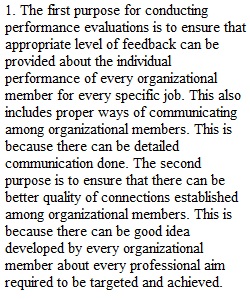


Q Chapter 10 Questions Answer the following items and upload your responses to the appropriate drop box by the due date. 1. What are the three purposes for conducting performance evaluations? Describe each. 2. Define the following criteria for developing effective performance evaluation systems:a. Fit with strategyb. Validityc. Reliabilityd. Acceptabilitye. Feedback 3. Provide an example of how a performance evaluation might be “contaminated”, as well as an example for “deficiency”. 4. What are the weaknesses for comparative evaluation approaches? 5. What are the drawbacks to using a graphic rating scale? 6. How do BARS, mixed methods, and BOS approaches to measuring performance improve upon graphic rating scales? 7. What are the pros and cons of using objective outputs to measure performance? 8. Describe a 360-degree performance appraisal. 9. Why should we make supervisors aware of rating errors and provide examples of the following types of biases:a. Halo/hornsb. Leniencyc. Strictness 10. What advice would you give to managers as they prepare to provide performance feedback to their employees?
View Related Questions